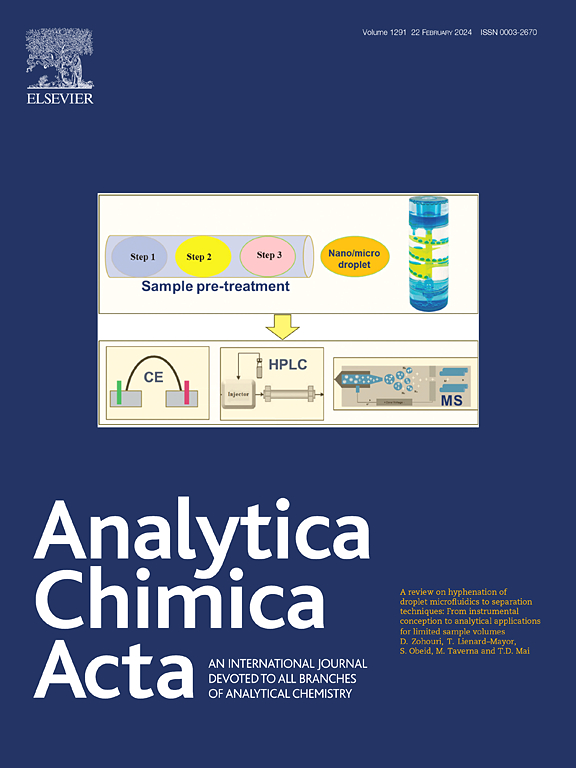A novel hydrazide-based fluorescent chemosensor and its application to recognize Cu2+ and glyphosate in environmental and biological systems
IF 5.7
2区 化学
Q1 CHEMISTRY, ANALYTICAL
引用次数: 0
Abstract
Background
Although copper ions (Cu2+) and glyphosate (GLY) tend to exist in the environment or living organisms at low doses, they gradually accumulate with exposure time and may eventually cause irreversible damage to living organisms. The existing detection methods are effective, but most of them lack the ability to detect multiple pollutants simultaneously or suffer from low sensitivity and poor selectivity. Therefore, it is important to develop a sensor that can efficiently and sensitively detect copper ions and glyphosate, but also has the potential for practical applications.
Results
In this study, a novel hydrazide-based DHBC capable of sequentially detecting Cu2+ and glyphosate (GLY) was developed. The DHBC forms a complex with Cu2+, causing fluorescence quenching. Upon exposure to GLY, functional groups such as carboxyl, phosphate, and amino groups coordinate with Cu2+, displacing DHBC and restoring fluorescence intensity. The mechanism has been validated by various characterization methods such as HRMS and Job curves, DFT calculation, etc. The DHBC has excellent detection performance, including high selectivity, strong anti-interference, fast response (less than 1 min), and high sensitivity (Cu2+: 0.09 μM, GLY: 0.05 μM). The quantitative analysis of Cu2+/GLY in cycling experiments and actual samples demonstrated the great potential of DHBC for practical applications. The DHBC successfully imaged Cu2+/GLY in live models such as HeLa cells and zebrafish, demonstrating its broad applicability and stability in a wide range of biological models.
Significance
The high accuracy of DHBC in environmental pollution monitoring and its stable performance in biological modeling make it an important tool for assessing the impact of pollutants on ecosystems and human health. In addition, the wide applicability and real-time imaging capability of DHBC provide reliable technical support for environmental science, toxicology, and health risk assessment and have important prospects for scientific research and practical applications.

一种新型肼基荧光化学传感器及其在环境和生物系统中识别Cu2+和草甘膦的应用
虽然铜离子(Cu2+)和草甘膦(GLY)在低剂量时往往存在于环境或生物体中,但随着暴露时间的延长,它们会逐渐积累,最终可能对生物体造成不可逆的损害。现有的检测方法是有效的,但大多缺乏同时检测多种污染物的能力或灵敏度低、选择性差。因此,开发一种能够高效、灵敏地检测铜离子和草甘膦的传感器非常重要,同时也具有实际应用的潜力。结果本研究建立了一种新型的肼基DHBC,能够对Cu2+和草甘膦(GLY)进行序列检测。DHBC与Cu2+形成络合物,引起荧光猝灭。暴露于GLY后,羧基、磷酸基和氨基等官能团与Cu2+配位,取代DHBC并恢复荧光强度。通过HRMS、Job曲线、DFT计算等多种表征方法对其机理进行了验证。DHBC具有选择性高、抗干扰性强、响应速度快(小于1 min)、灵敏度高(Cu2+: 0.09 μM, GLY: 0.05 μM)等优点。循环实验和实际样品中Cu2+/GLY的定量分析证明了DHBC在实际应用中的巨大潜力。DHBC成功地在HeLa细胞和斑马鱼等活体模型中成像Cu2+/GLY,证明了其在广泛的生物模型中的广泛适用性和稳定性。DHBC在环境污染监测中的高精度和在生物建模中的稳定性能使其成为评估污染物对生态系统和人类健康影响的重要工具。此外,DHBC的广泛适用性和实时成像能力为环境科学、毒理学和健康风险评估提供了可靠的技术支持,具有重要的科研和实际应用前景。
本文章由计算机程序翻译,如有差异,请以英文原文为准。
求助全文
约1分钟内获得全文
求助全文
来源期刊

Analytica Chimica Acta
化学-分析化学
CiteScore
10.40
自引率
6.50%
发文量
1081
审稿时长
38 days
期刊介绍:
Analytica Chimica Acta has an open access mirror journal Analytica Chimica Acta: X, sharing the same aims and scope, editorial team, submission system and rigorous peer review.
Analytica Chimica Acta provides a forum for the rapid publication of original research, and critical, comprehensive reviews dealing with all aspects of fundamental and applied modern analytical chemistry. The journal welcomes the submission of research papers which report studies concerning the development of new and significant analytical methodologies. In determining the suitability of submitted articles for publication, particular scrutiny will be placed on the degree of novelty and impact of the research and the extent to which it adds to the existing body of knowledge in analytical chemistry.
 求助内容:
求助内容: 应助结果提醒方式:
应助结果提醒方式:


